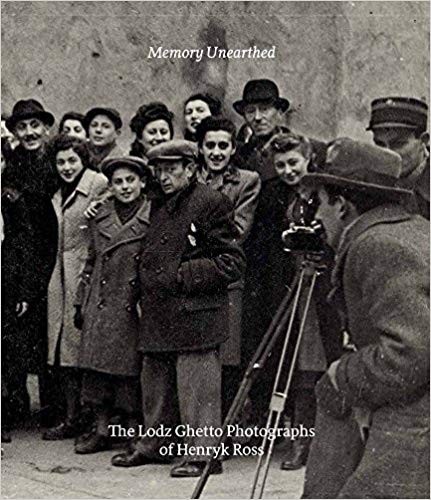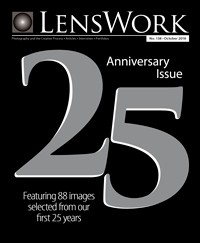Fotografiska: Coming to London and New York amid Controversy
Several Photography Award Winners Announced
AIPAD Past President and Founding Member Tom Halsted Passes Away
Tom Halsted: A Personal Perspective
Stuart Alexander Named Editor-in-Chief of Delpire
Quentin Bajac leaves NY MoMA for the Jeu de Paume in Paris
Photographer, Publisher and Teacher Michael A. Smith Passes Away
Photography Collector and Community Leader Gloria Katz Huyck Passes Away in L.A.
Manfred Heiting Home and Photobook Library Go up in Flames in Malibu Fire
Etherton Gallery Places W. Eugene Smith Minamata Archive with Library of Congress
Photo Book Reviews: Henryk Ross' Photographs of the Lodz Ghetto; Daiter Catalogs and Lenswork's 25th Anniversary Issue
Next Issue: Paris Photo Week Events and Paris Gustave Le Gray Auction Coverage.

MEMORY UNEARTHED: THE LODZ GHETTO PHOTOGRAPHS OF HENRYK ROSS by Bernice Eisenstein, et al. Art Gallery of Ontario/Yale University Press. 240 pgs.; softbound. A reprint of the original catalogue published in conjunction with the 2015 exhibition of the same name at Art Gallery of Ontario, Canada. ISBN No. 978-1-988788-01-2. Information: http://www.ago.ca; http://www.yalebooks.com/art.
Remarkable and wrenching, the Lodz Ghetto photographs of Henryk Ross weigh heavily on our postmodern sensibilities. Farther and farther removed from the carnage of World War II and the human stain of the Holocaust, we may respond with a certain historiographical detachment to these images of everyday life--and death--in the Nazi's concentration of Polish Jewry from 1940 to '45. But the turn of each page can snap us to mournful attention, and generate a rush of emotion.
Cheery images of crowded family life in the days before the truth of the Nazi horror dawned on the Lodz victims may be hardest to take, given the subtext of eventual slaughter. The photos of children fallen to the street from hunger, scavenging for scraps of food, pulling carts exhaustedly, or of young and old Jews lying dead in Lodz's makeshift morgue--the graphic evidence mounts wearily.
As an official photographer for the Jewish Council within the Lodz Ghetto, Ross (1910-1991) amassed thousands of photographs and negatives. Daringly documenting the atrocities along with the propagandistic images the Nazis demanded, Lodz had the foresight to preserve his act of witness. During the final liquidation of the ghetto, he buried his negatives with other artifacts in a carefully chosen plot of ground. He survived the Holocaust, and was able to excavate the negatives after the Red Army liberated Lodz in 1945.
Though many negatives were severely damaged, nearly 3,000 survived, along with a small group of original prints. Ross sent them to Israel, where they remained in his personal collection, until they found their way to the Art Gallery of Ontario as a gift from the Archive of Modern Conflict. The AGO--which digitized the negatives and preserves them (they were primarily produced on cellulose nitrate stock)--mounted its landmark exhibition, Memory Unearthed, in 2015, and this reprint of the catalogue is a testament to the ongoing, never-forget power of the subject matter and of Ross's heroism.
In his introduction, former AGO director Matthew Teitelbaum cites curator of photography Maia-Mari Sutnik for shepherding the Ross collection, the exhibitions and this book. In addition to the visual power of Ross's work, the volume delivers superb scholarship through a number of essays by Sutnik, as well as by Holocaust expert Robert Jan van Pelt, photographer and filmmaker Michael Mitchell, Eric Beck Rubin, who reflects on how Ross's treatment of the "everyday and the extreme" forces a reconsideration of the Holocaust, and Bernice Eisenstein, who reflects on the enduring power of memory.
The living memory of the shoah may be fading with the last survivors, but as Eisenstein abjures us, "It is impossible not to wish to make complete and fill to the measure the unknown lives of the ghosts who call to us for their remembrance."
Indeed, Ross's images epitomize photography's essential ghostliness--none of his Lodz subjects are identifiable by name--as the faces and forms of the myriad lost speak out to us with heartbreaking immediacy, and often tragic surprise. A photo of a young Lodz couple kissing in a spray of shrubbery evokes an impressionism worthy of Renoir, while the blurred shots of ghetto residents being tagged for deportation, crowding together desperately, are near-cinematic in effect.
Ross photographed from every imaginable vantage--from lookout posts that lent an eye-of-God quality to his crowd shots, with raking sunlight casting long shadows and bold contrasts, to frontal portraits of daily doings tinged with hard irony: residents watering gardens in the hope of growing some food, or ghetto police strolling among the hungry with full bags of bread and provisions. Children in classrooms calmly learn to knit, while women embroider goods for German shops, all under Polish watch, still unaware of their merciless fate.
"Today, when we picture the Holocaust, it is images of the extreme that fill our imaginations: tall piles of bodies, skin-and-bone Musselmanner at barbed-wire fences, and numberless horrific scenes of violence and humiliation," writes Eric Beck Rubin in his essay. "Ross gives us these images as well as their obverse: scenes of family dinners, portraits of assiduous workers and looks of happiness and hope, which are just as much a part of the Nazi genocide." Rubin argues that Memory Unearthed changes our comprehension of the Holocaust--that by its representation in the fullness of Ross's portfolio, we don't achieve an understanding so much as a disruption, a determination to "make us start over again."
PHOTOGRAPHY CATALOGS: Dawoud Bey's "Night Coming Tenderly, Black" is a small catalogue of eight plates produced on the occasion of the recent Chicago EXPO 2018 (Information: http://www.stephendaitergallery.com, or http://www.renabranstengallery.com).
Bey, renowned for his large-scale color portraits of African-Americans, adolescents and the marginalized (and recipient of a 2017 "Genius Grant" from the John D. and Catherine T. MacArthur Foundation), works in a smaller and more muted scale in this series.
Basing it on the fact and mythos of the Underground Railroad that brought American slaves up from the southland, Bey calls it "a visual reimagining of the movement of fugitive slaves through Cleveland and Hudson, Ohio landscape as they approached Lake Erie and the final passage to freedom in Canada." These dark-toned images utilize real and imagined sites to "recreate the spatial and sensory experiences of those moving furtively through the darkness." Dreamlike yet grounded in a strong sense of place and purpose, these eight images register subtly yet deeply--especially the key image of a single home guarded by a white picket fence, grayly visible as the camera moves with a runaway slave's carefulness along the road.

(Editor's note: we usually don't review magazine issues but this one was of major significance.) "LENSWORK 138" is the 25th anniversary issue of the influential publication that has brought so many photographers to greater notice and opportunity. The issue looks back on some 12,000 pages of LensWork history, with 88 selections that convey the range of fine-art work in the medium.
It features a wide range of styles, from the abstract formalism of artists working in black-and-white, such as Howard Schatz and Michael Rich, to the American West portraiture of Jay Dusard, Hiroshi Watanabe's Kabuki portraits, Maureen Gallagher's nude studies, Shelby Lee Adams' Appalachian images, Phil Borges' Tibetan folk portraits, R.R. Stone's "Faces of Mexico," and color work such as an image from dance photographer Lois Greenfield's stunning "Moving Still" series, a heavenly swirl of costumed choreography. Information: http://www.lenswork.com.
Finally, Chicago's Stephen Daiter Gallery (http://www.stephendaitergallery.com) offers "NOTED PHOTOS," a collection of vintage photographs from The Photo League. This rich sampling of images reaches back 17 years, when the gallery published an important book, This was the Photo League, generating interest in the immense contributions to photography's modernist vocabulary.
The catalogue spans selectively--from A (Berenice Abbott) to W (Edward Wallowitch, Weegee, Ida Wyman). In between are great images from the likes of Morris Engel, Leon Levenstein, Lisette Model, Marvin E. Newman, Ruth Orkin ("American Girl in Italy..Florence, 1951"), all classic representations of the urban experience, all transcending the notion of "street" photography with their rigorous dedication to exposure, composition and clarity.
Matt Damsker is an author and critic, who has written about photography and the arts for the Los Angeles Times, Hartford Courant, Philadelphia Bulletin, Rolling Stone magazine and other publications. His book, "Rock Voices", was published in 1981 by St. Martin's Press. His essay in the book, "Marcus Doyle: Night Vision" was published in the fall of 2005. He currently reviews books for U.S.A. Today.
(Book publishers, authors and photography galleries/dealers may send review copies to us at: I Photo Central, 258 Inverness Circle, Chalfont, PA 18914. We do not guarantee that we will review all books or catalogues that we receive. Books must be aimed at photography collecting, not how-to books for photographers.)
Fotografiska: Coming to London and New York amid Controversy
Several Photography Award Winners Announced
AIPAD Past President and Founding Member Tom Halsted Passes Away
Tom Halsted: A Personal Perspective
Stuart Alexander Named Editor-in-Chief of Delpire
Quentin Bajac leaves NY MoMA for the Jeu de Paume in Paris
Photographer, Publisher and Teacher Michael A. Smith Passes Away
Photography Collector and Community Leader Gloria Katz Huyck Passes Away in L.A.
Manfred Heiting Home and Photobook Library Go up in Flames in Malibu Fire
Etherton Gallery Places W. Eugene Smith Minamata Archive with Library of Congress
Photo Book Reviews: Henryk Ross' Photographs of the Lodz Ghetto; Daiter Catalogs and Lenswork's 25th Anniversary Issue
Next Issue: Paris Photo Week Events and Paris Gustave Le Gray Auction Coverage.


Share This